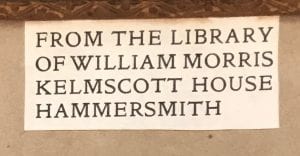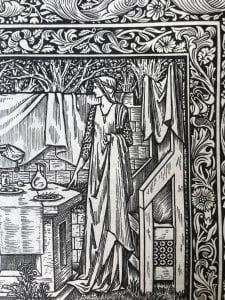Kelmscottiana: Books Owned and Published by William Morris
Special Collections and University Archives has recently enlarged its holdings of materials related to British designer William Morris (1834-1896), including the purchase of two printed leaves from Kelmscott Press’s The works of Geoffrey Chaucer and the cataloguing of a sixteenth century book printed by Wynken de Worde that was previously part of Morris’s personal library at Kelmscott House.
Ex libris: From the library of William Morris

Floure of the commandments of God is printed in two columns of Gothic letter, with two woodcut illustrations and inhabited initials throughout, some with grotesque heads. It is a small folio, measuring 29cm tall, and bound in calfskin. It is not a perfect copy, lacking the first 12 leaves and the last two leaves in facsimile (including de Worde’s printer’s device). This condition is noted in the Sotheby’s 1898 sale catalogue, where it was sold during the dispersement of the bulk of Morris’s library. There are also traces of a previous reader’s censorship (crossing-out) of the word “Pope.”
- Photo by Ashlee W. [Andrew Chertsey, The floure of the commaundementes of god (London: Wynken de Worde, 1510), BV4655 .F55 1510, Special Collections and University Archives, University of Oregon Libraries, Eugene, Oregon.]
- [Andrew Chertsey, The floure of the commaundementes of god (London: Wynken de Worde, 1510), BV4655 .F55 1510, Special Collections and University Archives, University of Oregon Libraries, Eugene, Oregon.]
We recognize William Morris as one of the previous owners of this copy through the presence of his bookplate on the interior cover that reads, “From the library of William Morris, Kelmscott House, Hammersmith.” In addition to Morris’s work in design and bookmaking with the Kelmscott Press, he also was an avid book collector and held many volumes in his personal library. His library included a wide range of books, from medieval manuscripts and incunabula to contemporary nineteenth century works. Most recently, scholars William S. Peterson and Sylvia Holton Peterson have been compiling a catalogue of Morris’s library to record the provenance and current locations of the books and manuscripts previously owned at Kelmscott House, which currently includes 2,400 entries.
UO Special Collections and University Archives also holds a second book bearing Morris’s bookplate from Kelmscott House, Astesano’s Summa de casibus conscientiae, a fifteenth century work on canon law. These two books from Morris’s library came to Special Collections and University Archives with the 1980 acquisition of Bishop William A. Quayle’s collection of books on the history of printing.
Specimen of fine printing: Leaves from Kelmscott’s Chaucer


More Kelmscott works
These works supplement a modest collection of other works published by the Kelmscott Press and William Morris held by Special Collections and University Archives including: The Nature of Gothic: A Chapter of the Stones of Venice (1892), The Recuyell of the Histories of Troye (1892), Maud: A Monodrama (1893), The Wood Beyond the World (1894), Of the Friendship of Amis and Amile (1894), and The Shepheardes Calendar (1896) and others.
Sources:
- Richmond, Velma Bourgeois. “Edward Burne-Jones’s Chaucer Portraits in the Kelmscott “Chaucer”. The Chaucer Review 40, no. 1 (2005): 1-38.



